Chatbots have become essential tools for businesses, handling everything from answering FAQs to providing personalized recommendations.
But what sets a good chatbot apart from a great one?
The answer lies in its persona. A chatbot persona shapes the tone, style, and personality of its interactions with users. When thoughtfully crafted, it builds trust, boosts engagement, and enhances the overall customer experience. With AI-powered chatbots like Tidio’s Lyro, creating a personalized, human-like support system is simpler than ever.
Let’s dive deeper and explore essential steps to create a great chatbot persona that fits your needs.
Design your perfect chatbot persona with Lyro
What is a chatbot persona?
In a nutshell, a chatbot persona is the personality of your bot. It encompasses the tone, language, and style your chatbot uses to interact with users, reflecting your brand values and voice.
Unlike a generic chatbot, which offers robotic, one-size-fits-all responses, a conversational AI with a defined persona feels relatable, engaging, and tailored to your audience.
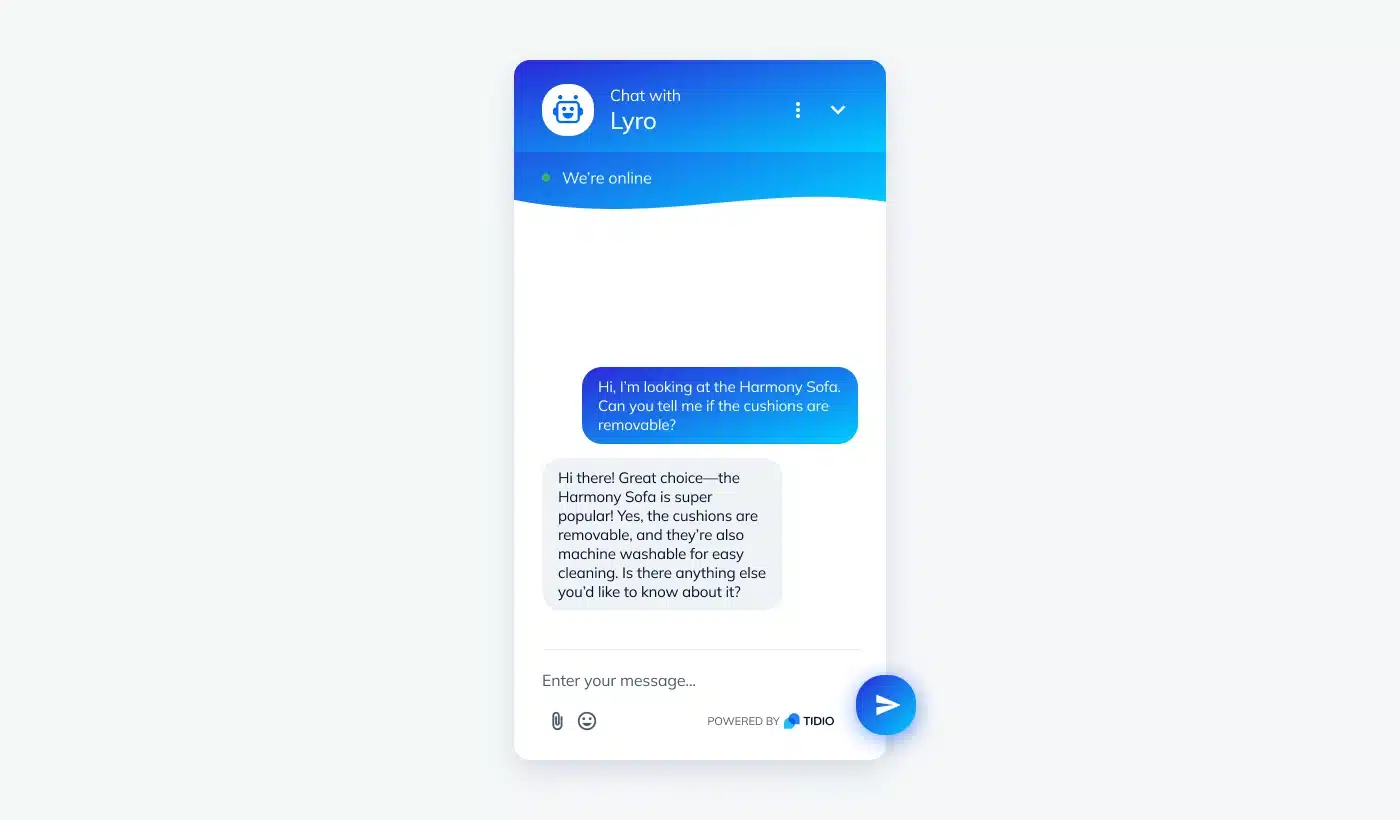
For instance, Lyro AI chatbot’s customization options allow businesses to adjust tone and personality settings, ensuring the bot’s voice aligns seamlessly with their brand identity.
Why is a chatbot persona important?
A relatable and consistent chatbot persona dramatically improves the quality of user interactions. It ensures that your chatbot resonates with users and enhances the overall experience.
Here are the key benefits of having a strong chatbot persona:
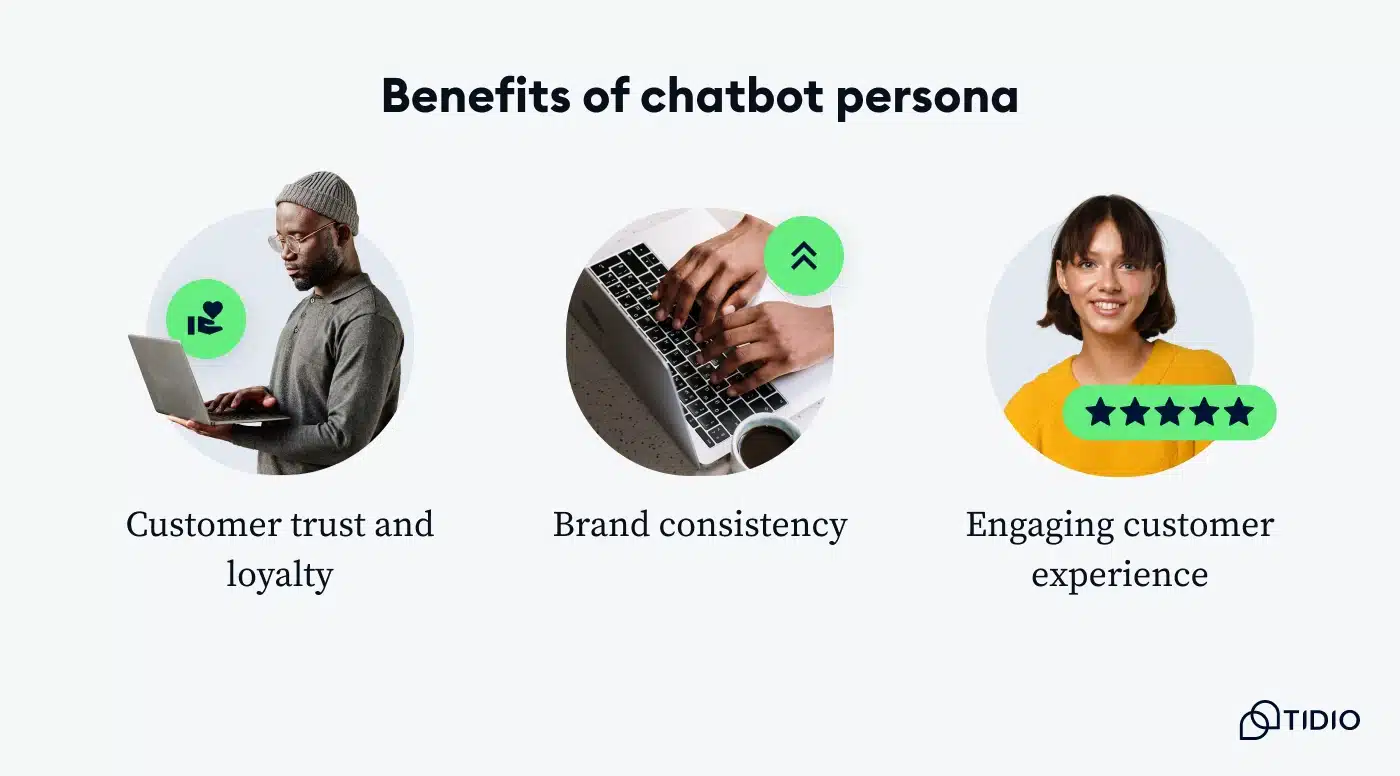
- Customer trust and loyalty: A well-crafted persona makes interactions feel more authentic, encouraging users to trust your brand. According to our chatbot study, about 64% of people trust AI chatbots. Additionally, 74% of respondents in our survey stated they prefer a chatbot to introduce itself at the start of the conversation, which can further promote trust.
- Brand consistency: By reflecting your brand’s voice, the chatbot emphasizes your identity, ensuring a consistent chatbot experience across all touchpoints.
- Engaging customer experience: A chatbot with personality captures attention and keeps users engaged, making conversations enjoyable rather than transactional. In fact, more than 87% of consumers have positive or neutral experiences with chatbots. So, adding personality to your chatbot can turn routine interactions into memorable experiences.
A step-by-step guide to creating a perfect chatbot persona
Let’s explore the essential steps you should take to design a chatbot persona that truly stands out. We’ll use our Lyro AI Chatbot as an example since its customization options help align the bot with your brand hassle-free.
Step 1: Define your target audience
Understanding your audience is the first step in creating a successful chatbot persona. Who are your customers and what drives them to interact with your business? Are they looking for quick answers to specific questions or prefer in-depth assistance for their issues?
To effectively define your target audience, start by analyzing existing customer data. Review support tickets, survey responses, and website behavior to identify recurring patterns and pain points.
Our study revealed that 77% of users want chatbots to clearly outline what they can assist with before starting the conversation. Keeping this in mind when defining your chatbot’s target audience helps you align its tone and capabilities with user expectations.
For example, if your audience frequently asks about order tracking, your chatbot should prioritize providing instant updates in a clear and friendly tone.
Lyro AI’s ability to analyze visitor behavior and tailor responses based on user needs makes this process seamless. Additionally, Lyro’s Hub panel provides insights that can help you further refine your chatbot’s persona.
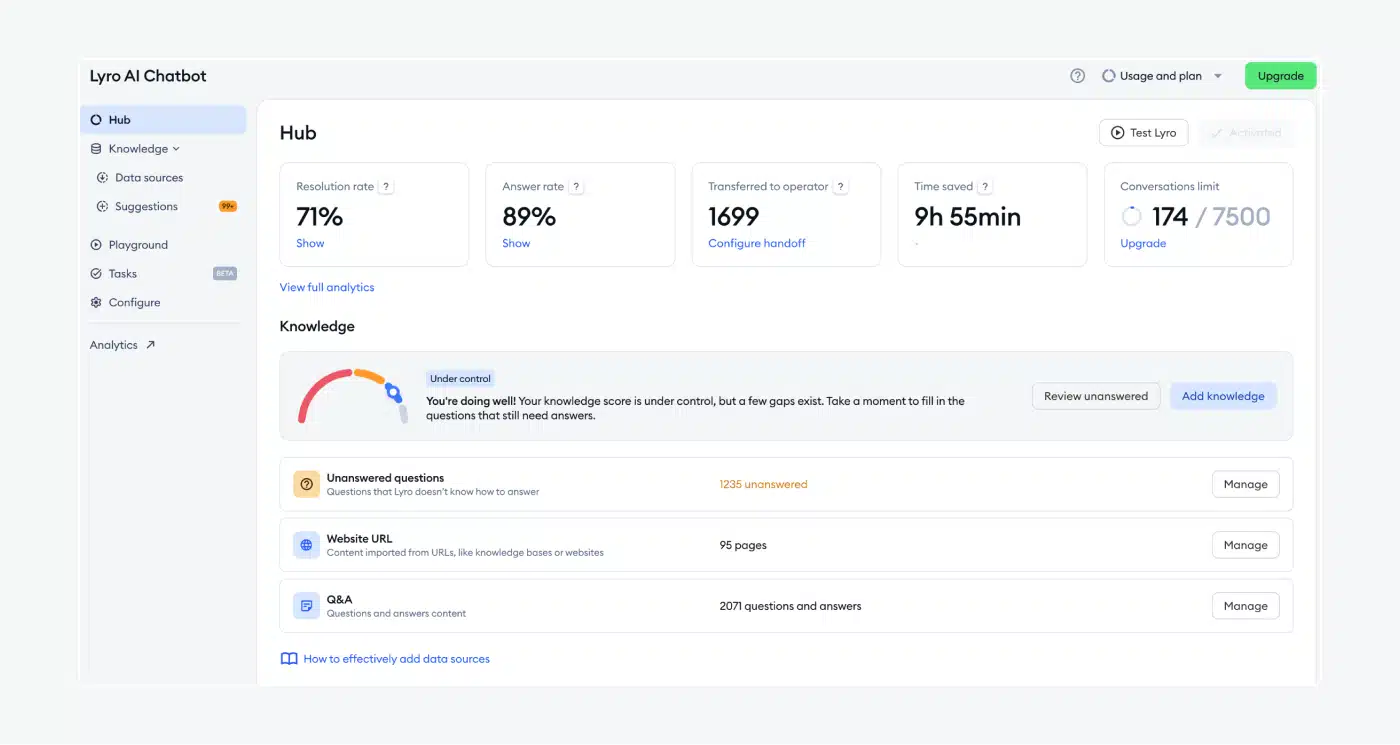
The Suggestions panel highlights unanswered customer questions and offers industry-specific recommendations for new questions your bot should address. This makes your chatbot not just reactive but proactive, improving its performance and meeting user expectations.

Read more: Learn how to take full advantage of Lyro’s Data Sources.
Step 2: Align the chatbot persona with your brand identity
Your chatbot should serve as an extension of your brand, with its tone, personality, and language reflecting your company’s identity and values.
To achieve a successful alignment, consider developing a style guide for your chatbot. This guide should outline acceptable phrases, emojis, and tone variations that fit your brand voice.
For instance, a travel company’s chatbot could use light humor and travel-themed expressions, while a finance chatbot might stick to straightforward, jargon-free language.
Lyro’s Personality options provide tools to customize the chatbot’s tone and style to suit your business needs. In the Configure > Personality tab, you can:
- Change the tone of voice: Choose between neutral, friendly, or formal tones to match your brand’s identity. This feature helps your chatbot connect with customers in a way that feels natural and consistent.
- Disable emojis: If emojis don’t fit your brand’s communication style, you can disable them by toggling the Use emojis switch under the Answer personalization section.
- Customize predefined messages: Modify certain default responses to better reflect your brand’s voice or address specific customer needs.
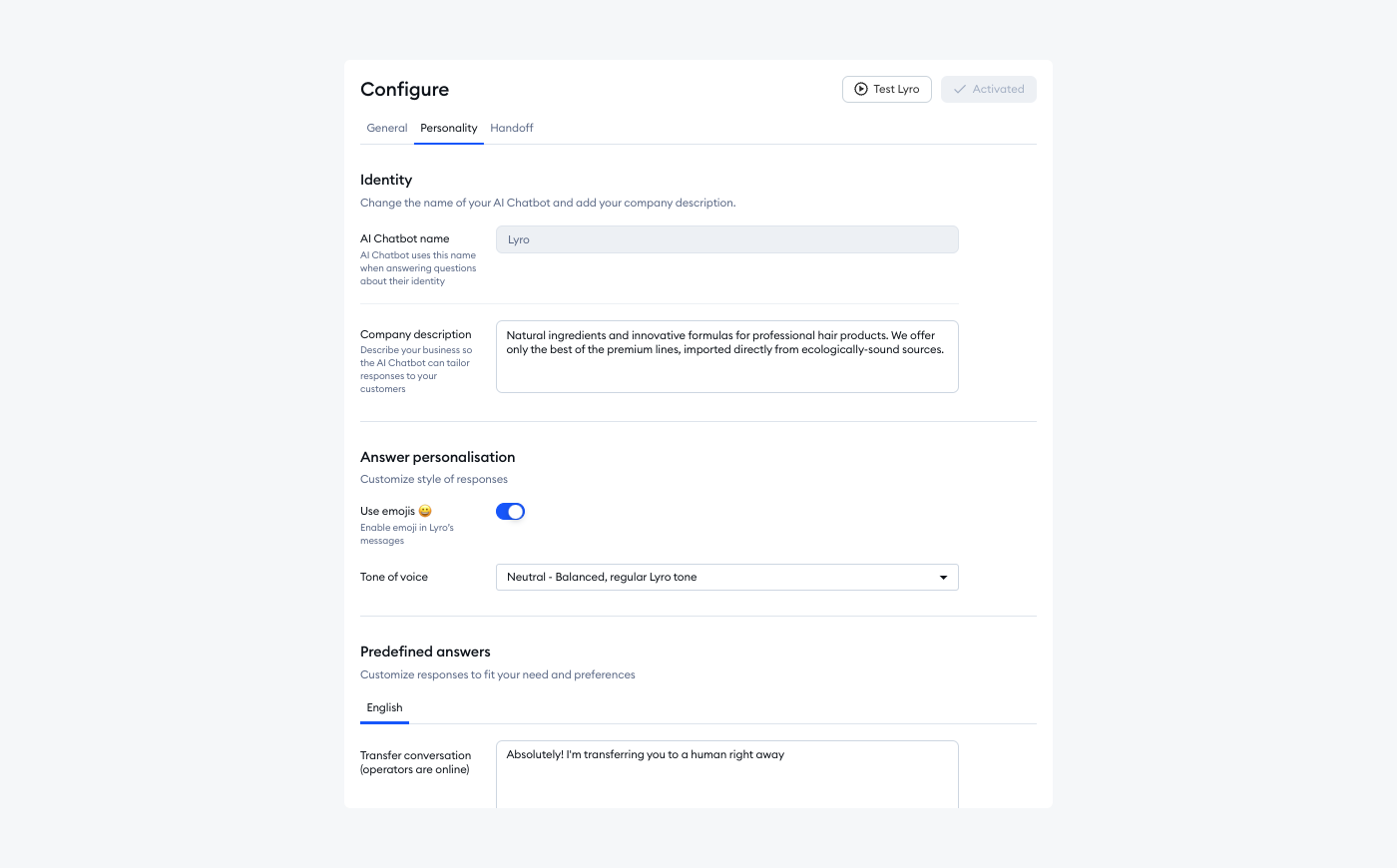
Step 3: Create a chatbot personality profile
To make your chatbot’s persona consistent, outline its personality profile. This profile serves as a comprehensive blueprint, ensuring the chatbot’s messages remain on-brand and relatable to your audience. Consider including these elements when building your chatbot’s personality:
Background
Give your chatbot a relatable backstory to humanize it. For instance, you might craft a description like, “I’m Lyro, your friendly shopping assistant, here to make your online experience seamless and enjoyable.” Using Lyro’s Identity and Company Description options, you can add details about the bot’s role, purpose, and expertise, making it feel more authentic and aligned with your brand.
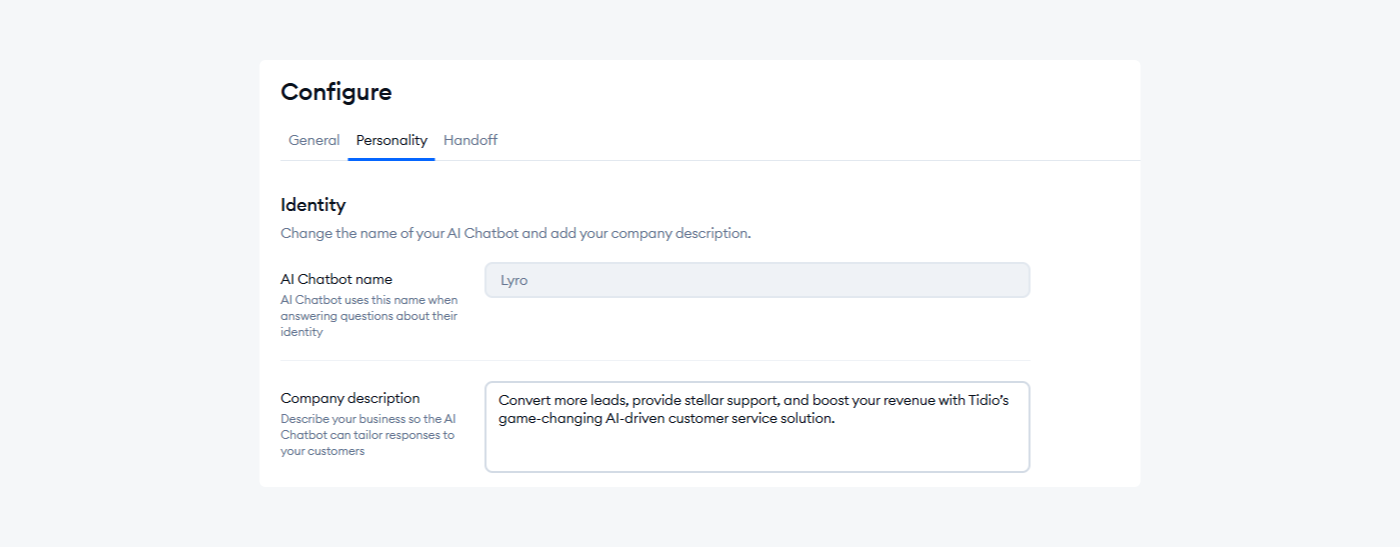
Preferred responses
Define the style of responses your AI agent should prioritize. Should they be concise or detailed? Friendly or strictly professional? Lyro’s Data Sources tab allows you to manually add Q&As to ensure the chatbot provides accurate and brand-aligned answers.
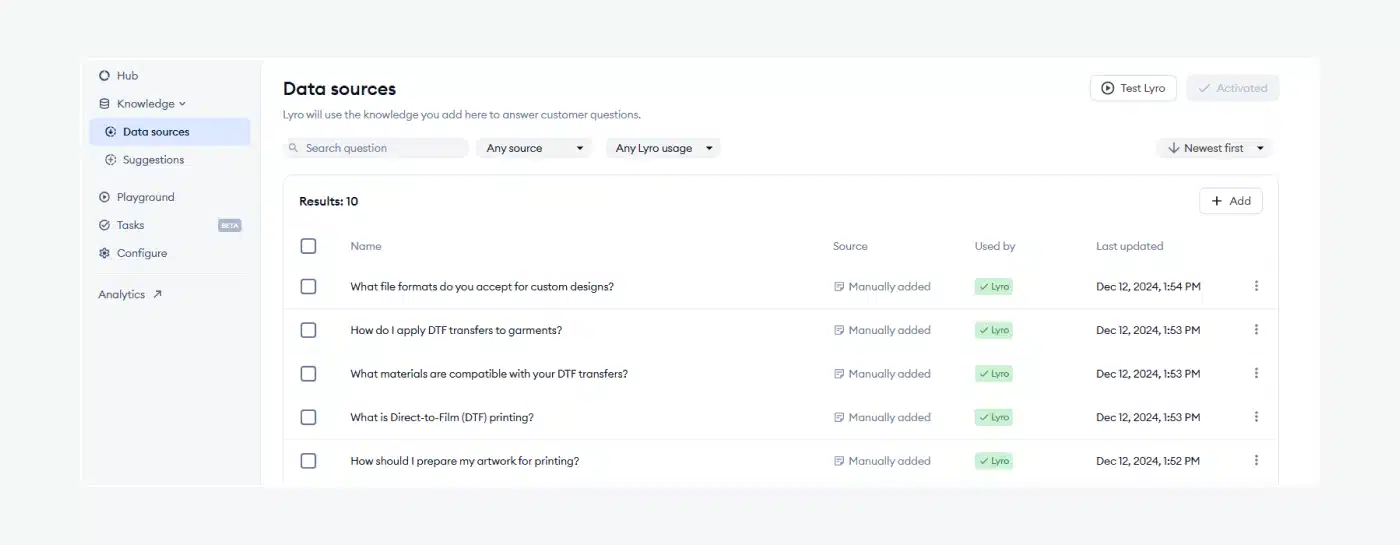
Tone testing
Use Lyro’s Playground feature to test the chatbot on how it answers common or complex questions. This helps you fine-tune its responses to match your brand’s tone and ensure clear, consistent interactions. For instance, if you’d prefer a more formal tone when communicating with customers, you can adjust and refine the chatbot’s replies accordingly.
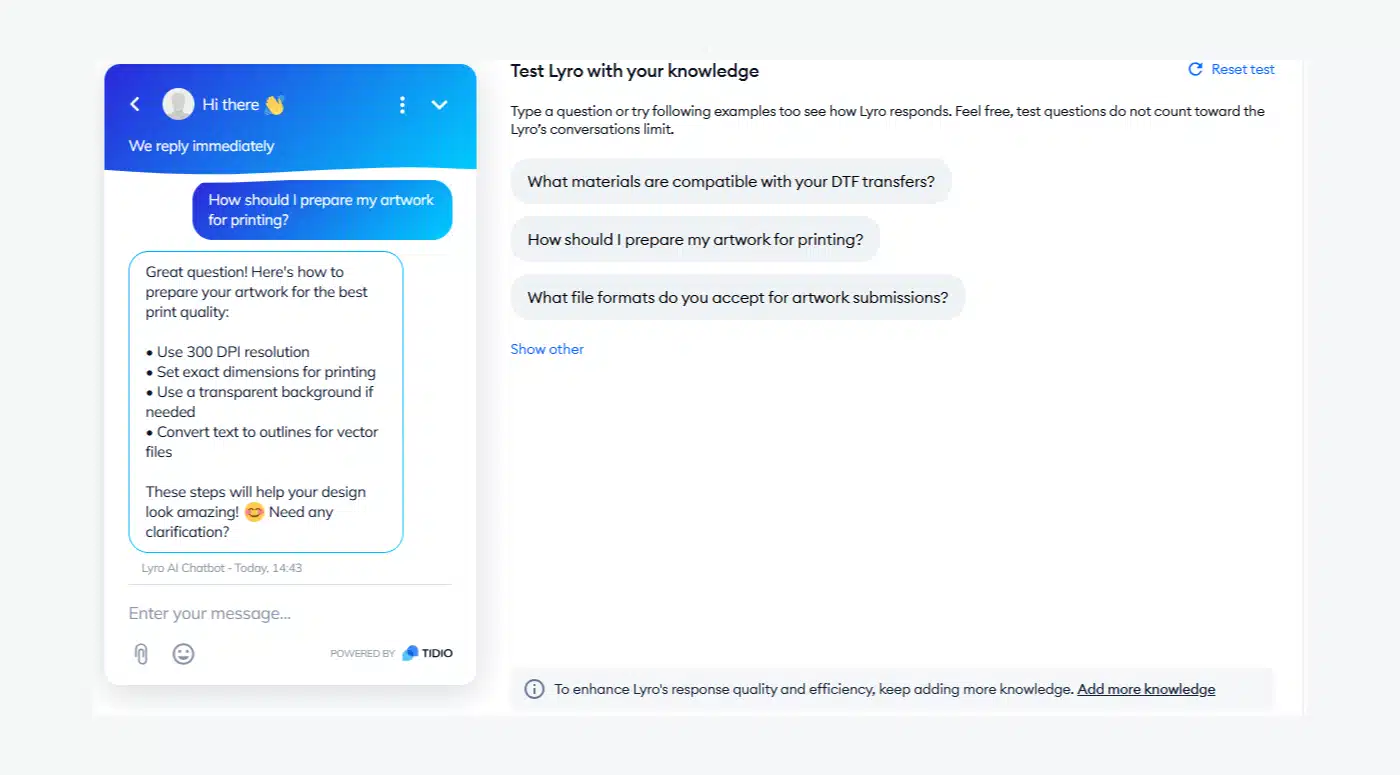
Create engaging chatbot persona with Lyro
Step 4: Observe performance trends and gather user feedback
Once your chatbot is live, monitor how well its persona resonates with users. Look for patterns in customer interactions to identify what works and what doesn’t. For example:
Are users frequently asking questions the chatbot can’t answer? If so, expand its AI knowledge base.
Are certain phrases or tones eliciting positive responses? Incorporate more of these elements into the chatbot’s interactions.
Lyro’s Suggestions panel is invaluable here, highlighting unanswered questions or common themes that require attention. Additionally, chat surveys provide direct feedback from users, helping you understand how satisfied they are with the chatbot’s performance.
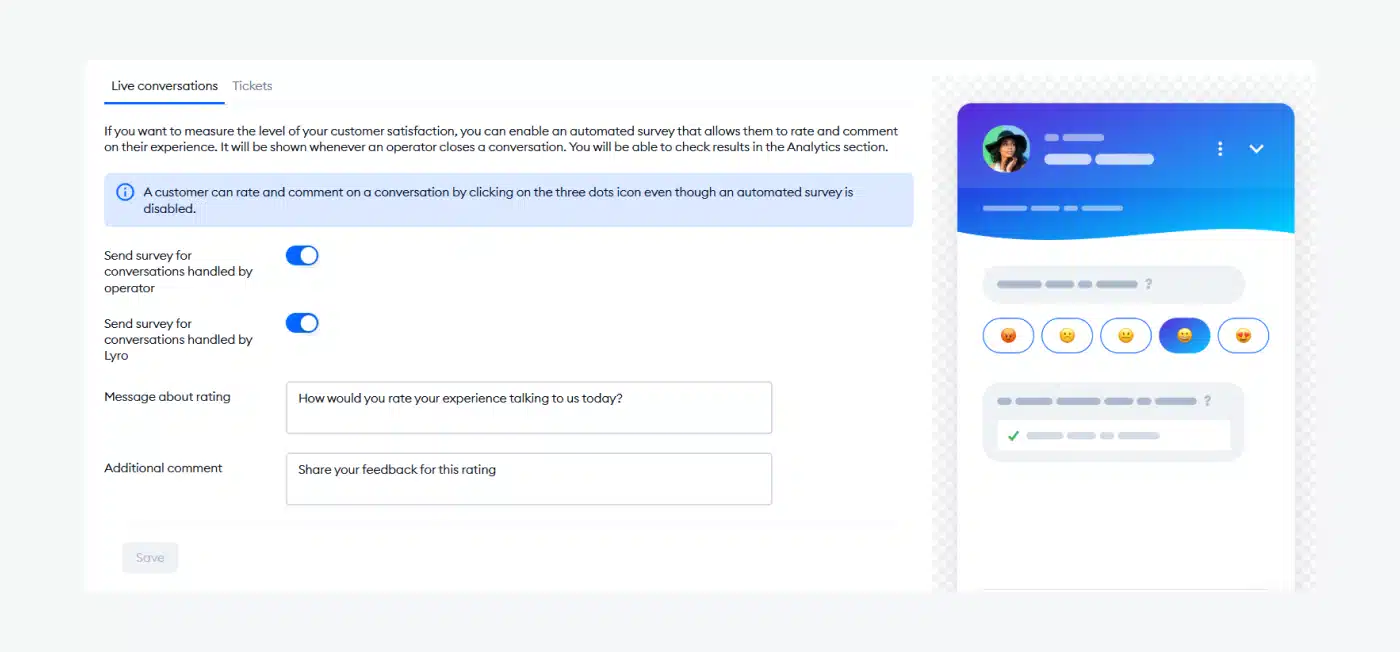
For instance, if users mention that the chatbot feels too robotic, consider adjusting its tone to be more conversational. If they appreciate its quick responses but wish for more detailed explanations, add depth to its answers. Continuous refinement ensures your chatbot’s persona meets user expectations, no matter what.
Read more: Check out the best customer feedback strategies you can use for your business needs.
Step 5: Measure the success of your chatbot persona
To assess the effectiveness of your chatbot’s persona, track both qualitative and quantitative metrics. These insights help you pinpoint areas for improvement and highlight what’s working well. Key metrics include:
- CSAT (Customer Satisfaction Score): Gauge how satisfied users are after interacting with your chatbot. A high CSAT score indicates that your chatbot’s persona and functionality align with user expectations.
- Engagement rate: Measure how many users actively interact with your chatbot. High customer engagement often reflects an approachable and helpful persona.
- Conversion rate: Assess your chatbot’s ability to turn inquiries into actions, such as completing a purchase or booking a service.

Lyro’s Analytics dashboard offers insights into resolution rates and answer accuracy, helping you identify strengths and areas for improvement. For example, if engagement rates are high but conversion rates lag, you might need to refine your chatbot’s ability to guide users toward completing specific actions.
Read more: Find out which key chatbot analytics and metrics you should track.
Successful chatbot personality examples
Chatbots are transforming businesses with their ability to provide instant support and maintain a consistent brand voice. Industries like healthcare and banking, which handle large volumes of human interactions, are particularly well-positioned to benefit from this technology.
Here are some real-world examples and use cases of chatbot personas that deliver exceptional results:
Ninja Transfers
Ninja Transfers, a custom printing services provider, uses a Lyro chatbot to deliver support with a blend of approachability and professionalism. Designed with a friendly and casual tone, the chatbot reflects Ninja Transfers’ brand identity, making interactions engaging and customer-centric.
Whether answering common queries about Direct-to-Film printing or recommending complementary products, Lyro ensures users feel understood and supported throughout their journey.
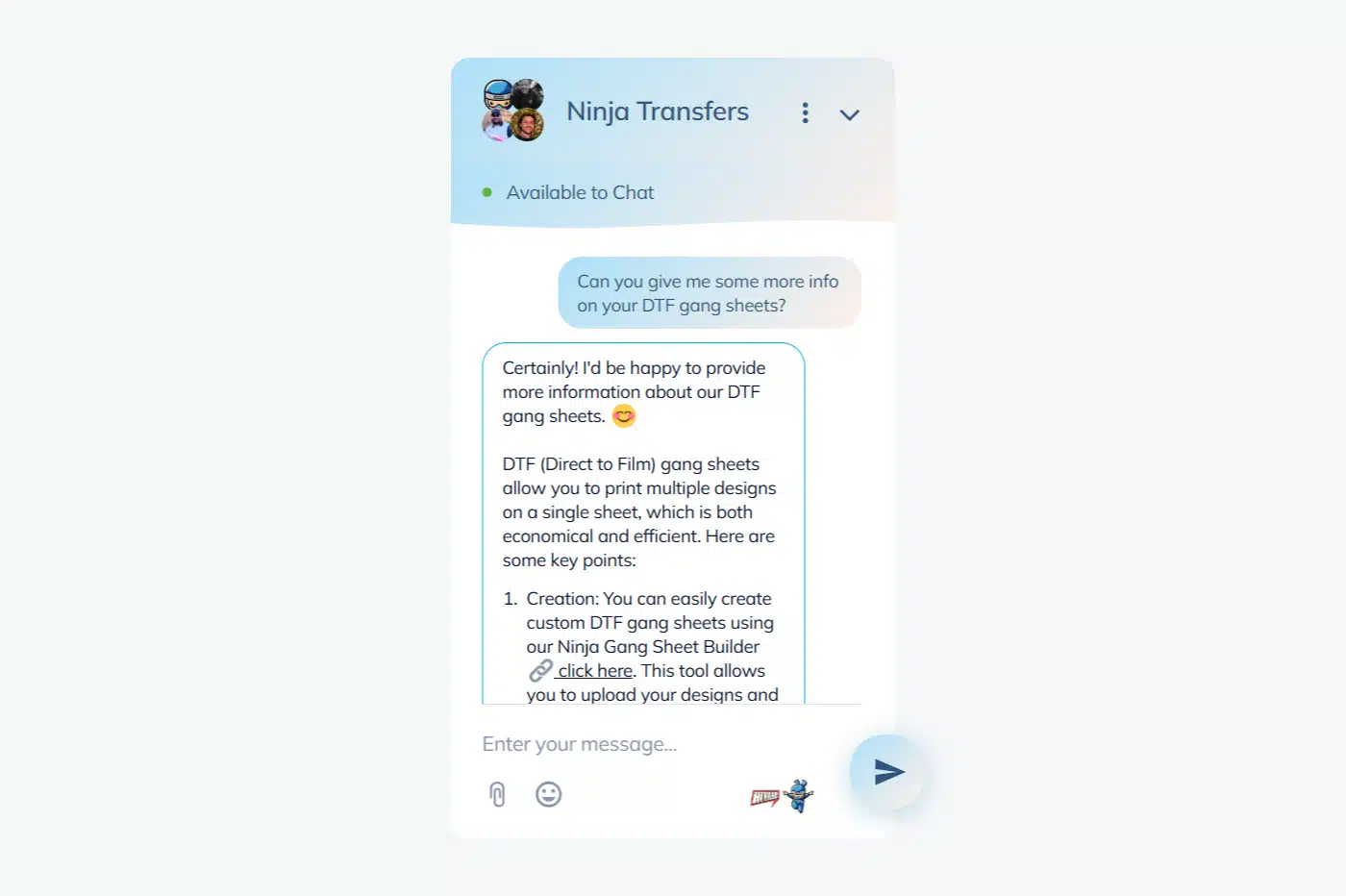
The persona of their AI chatbot is not only approachable but also highly functional. By leveraging Lyro’s customizable tone settings, Ninja Transfers tailored the chatbot to handle customer inquiries efficiently while maintaining a warm, conversational style.
Read more: Learn how to boost profitability with AI for custom printing services.
Helmi for Varma
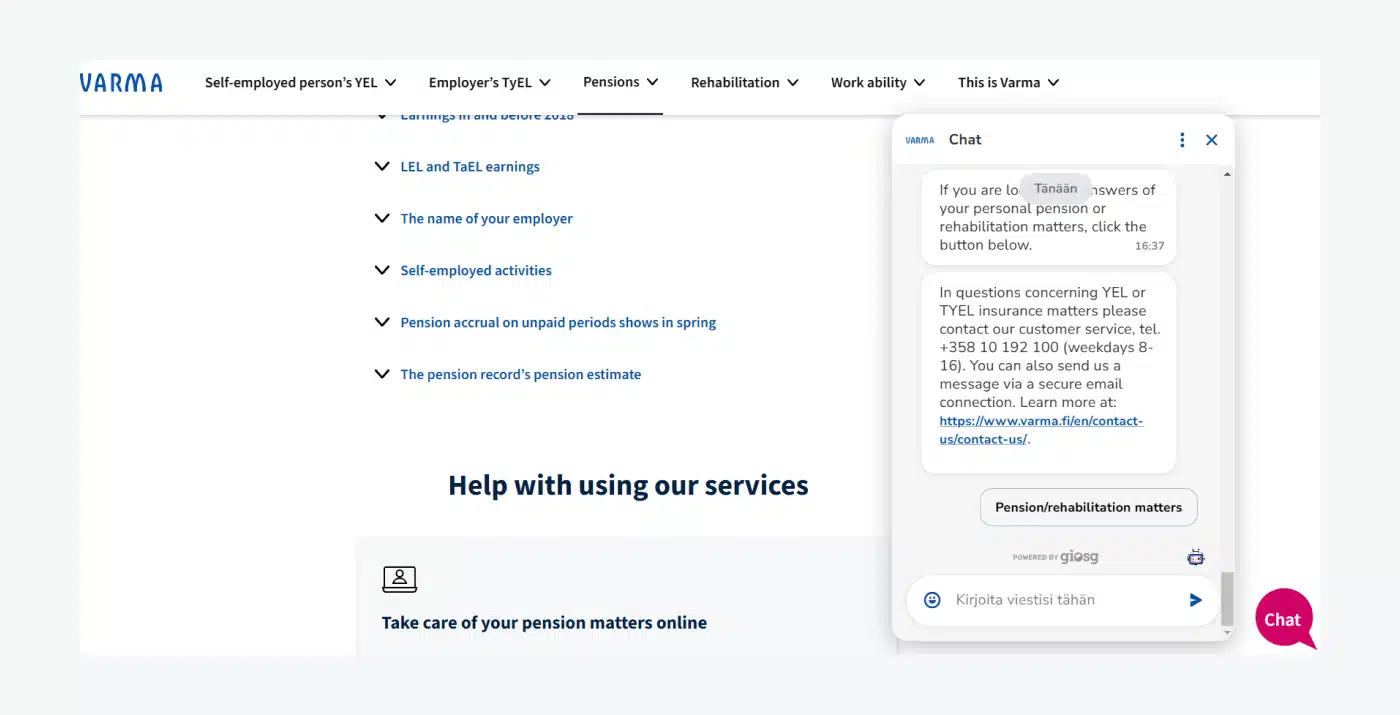
Varma, a leading pension insurance company, developed a chatbot named Helmi using the GetJenny platform. Helmi is designed to provide consistent, 24/7 customer support, addressing common queries related to pensions and financial services with clarity and efficiency.
While Helmi’s personality is professional and solution-oriented, it also incorporates a touch of approachability, ensuring users feel supported when navigating complex financial topics.
Read more: Explore the best banking chatbot use cases and examples.
La Llave de Oro
La Llave de Oro, a real estate development company, uses Serviceform’s chatbot to streamline client interactions and drive engagement. The chatbot adopts a slightly formal yet friendly tone, aligning well with the professional nature of the real estate industry. Its primary goal is to guide users toward scheduling a call with a representative, ensuring prospective clients can easily access personalized assistance.
![La Llave de Oro using a chatbot that guides real estate customers to schedule calls with representatives in a polite and efficient manner.]](https://www.tidio.com/wp-content/uploads/13-la-llave-de-oro-using-serviceform-chatbot.webp)
While it mainly focuses on functionality, the chatbot remains polite and efficient, providing users with clear information about available properties, pricing, and services.
Read more: Here are the top real estate chatbots on the market.
Buoy Health for OptimalMD
OptimalMD utilizes the Buoy Health chatbot to provide its members with accessible and cost-effective healthcare services. Buoy Health acts as a virtual health assistant, helping users navigate their medical concerns with ease. The chatbot’s tone is helpful and professional, making sure users feel supported while receiving tailored advice.
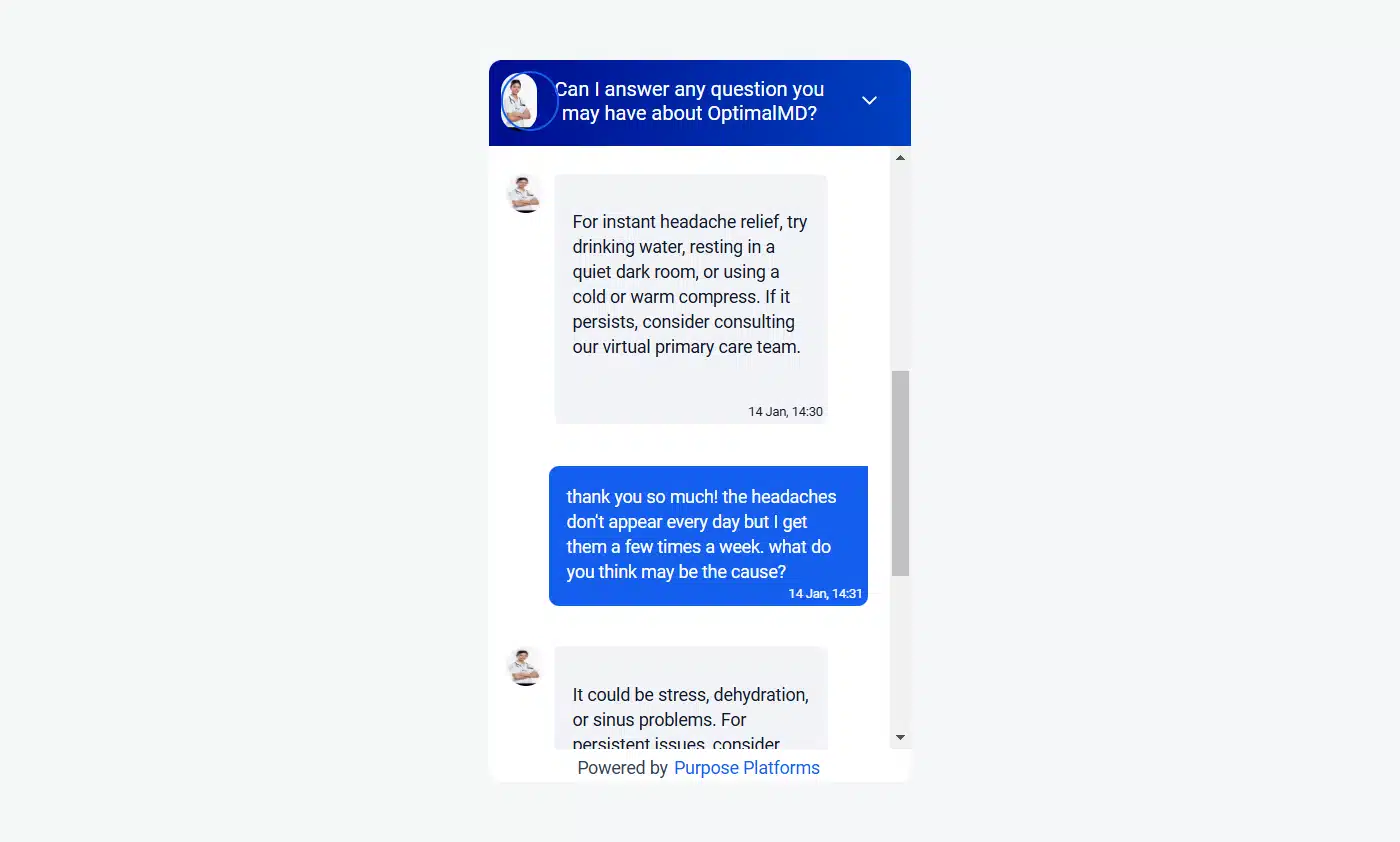
For example, the chatbot provides actionable recommendations for minor health issues, such as advice for headache relief. It also identifies potential causes of recurring symptoms and guides users toward OptimalMD’s virtual primary care team for further evaluation.
Common mistakes to avoid when creating your chatbot persona
Crafting a chatbot persona is a delicate balance between reflecting your brand and resonating with your audience. While a well-designed persona can boost user engagement and trust, certain mistakes can have the opposite effect.
Here are some common pitfalls to watch out for and how to address them effectively:
Misaligned persona
A persona that doesn’t reflect your target audience’s preferences can lead to disengagement. For example, using a playful tone for a financial services chatbot may alienate users expecting professionalism.
Ensure your chatbot’s personality matches your industry and customer expectations by researching your audience and testing its tone.
Excessive personality traits
Overloading the chatbot with quirks or unnecessary conversational elements can sacrifice functionality, frustrating users. At the same time, a lack of personality can make it feel robotic and frustrating. In fact, 22% of respondents in our survey cited overly robotic chatbot responses as a major frustration, while 47% of users would close a chat window if the bot gave repetitive answers.
Find the right balance between personality and functionality to keep the bot engaging while delivering stellar support.
Neglecting regional differences
Failing to adapt its persona to different languages or regions can create inconsistencies that hurt user experience. For instance, phrases or humor that work in one region might not translate well in another.
Lyro’s multilingual capabilities allow you to customize the chatbot’s tone and responses for various languages, allowing a seamless user experience worldwide. By localizing your bot’s persona, you can better connect with diverse audiences while maintaining brand consistency.
Read more: Here are all the steps you need to take to build a multilingual chatbot.
Chatbot personality templates
When it comes to designing your chatbot’s persona, starting with a solid template can make all the difference. We’ve prepared a few ready-to-use ideas perfect for different business needs.
Friendly retail bot
This chatbot template is all about being cheerful and casual, perfect for ecommerce brands that want to create a welcoming vibe with natural language. It might greet users with something like, “Hi there! Looking for something special today? I’d love to help!” Its warm and approachable tone makes shopping feel easy and enjoyable, encouraging customers to come back for more.
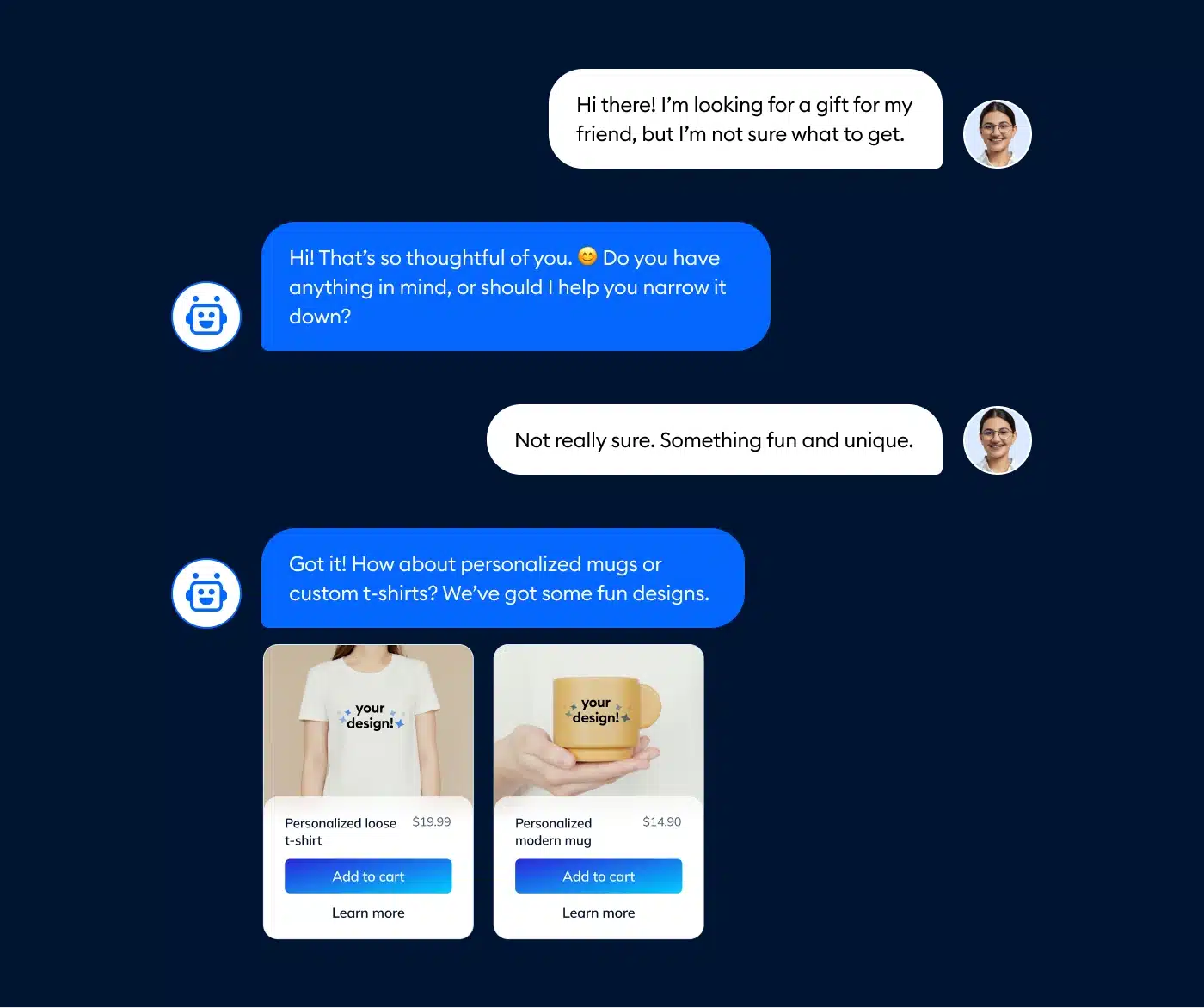
Read more: Explore the best ecommerce chatbots for your business.
Professional support bot
If your business operates in a more formal space like B2B services, this chatbot persona is all about being clear, concise, and reliable. Think of it as your go-to expert, saying things like, “Hello. How can I assist you today? I’m here to provide detailed answers to your queries.” This style helps build trust and shows your expertise.
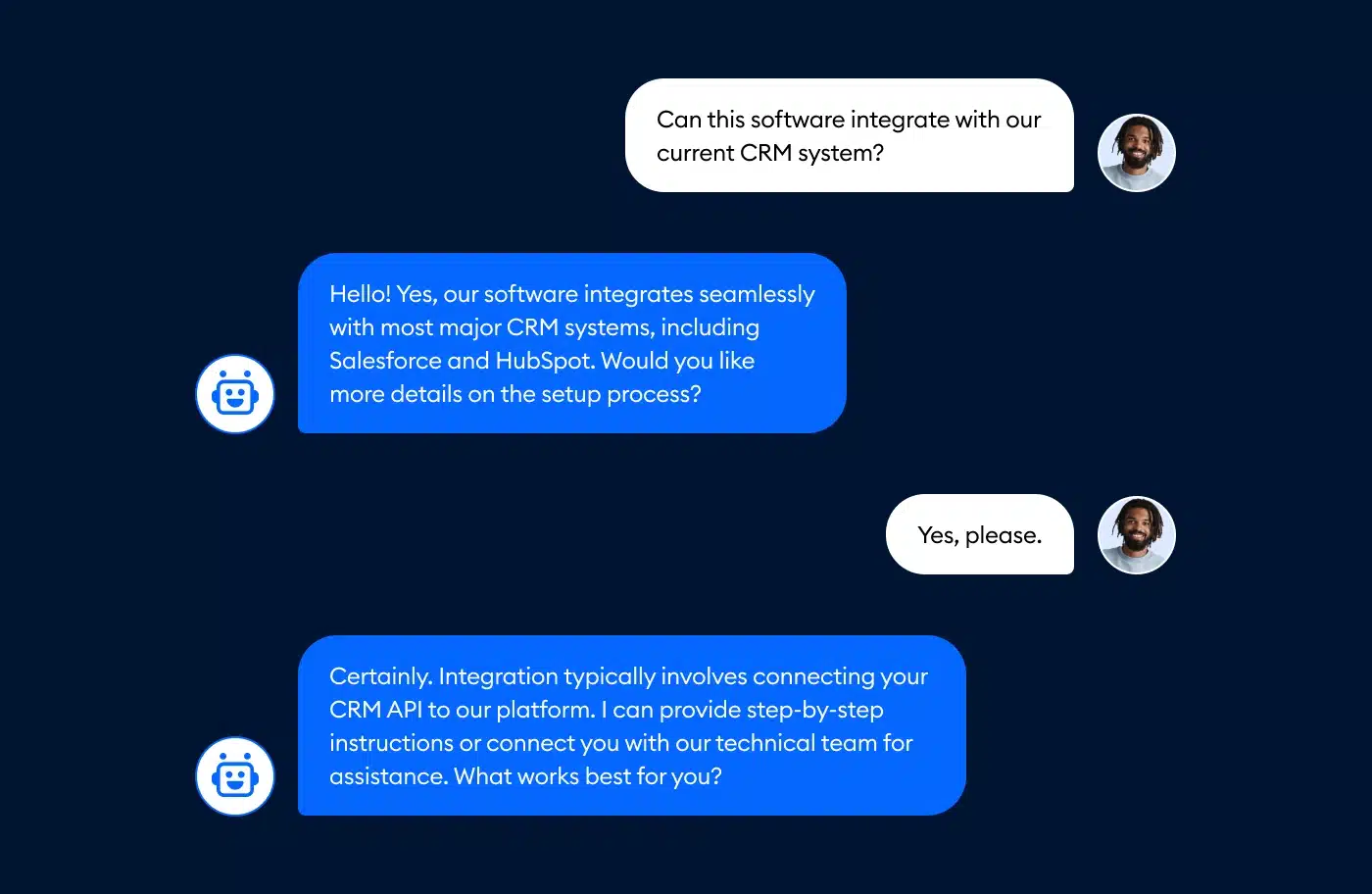
Neutral helper bot
Balancing friendliness and professionalism, this chatbot template is perfect for businesses that cater to a wide range of audiences. It uses clear and straightforward language to keep interactions efficient without losing a personal touch.
For example, it might say, “Hi! Let me know how I can assist you today. I’m here to provide the information you need.” This tone works well for anything from healthcare providers and government agencies to educational institutions and financial services.
The best part? You can take these templates and tweak them to fit your unique brand using Lyro’s customization options. If you want to tone down the humor or add a more personal touch, Lyro lets you adjust everything from tone and language to whether emojis are used. That way, your chatbot feels like a natural extension of your brand, tailored to your audience and their expectations.
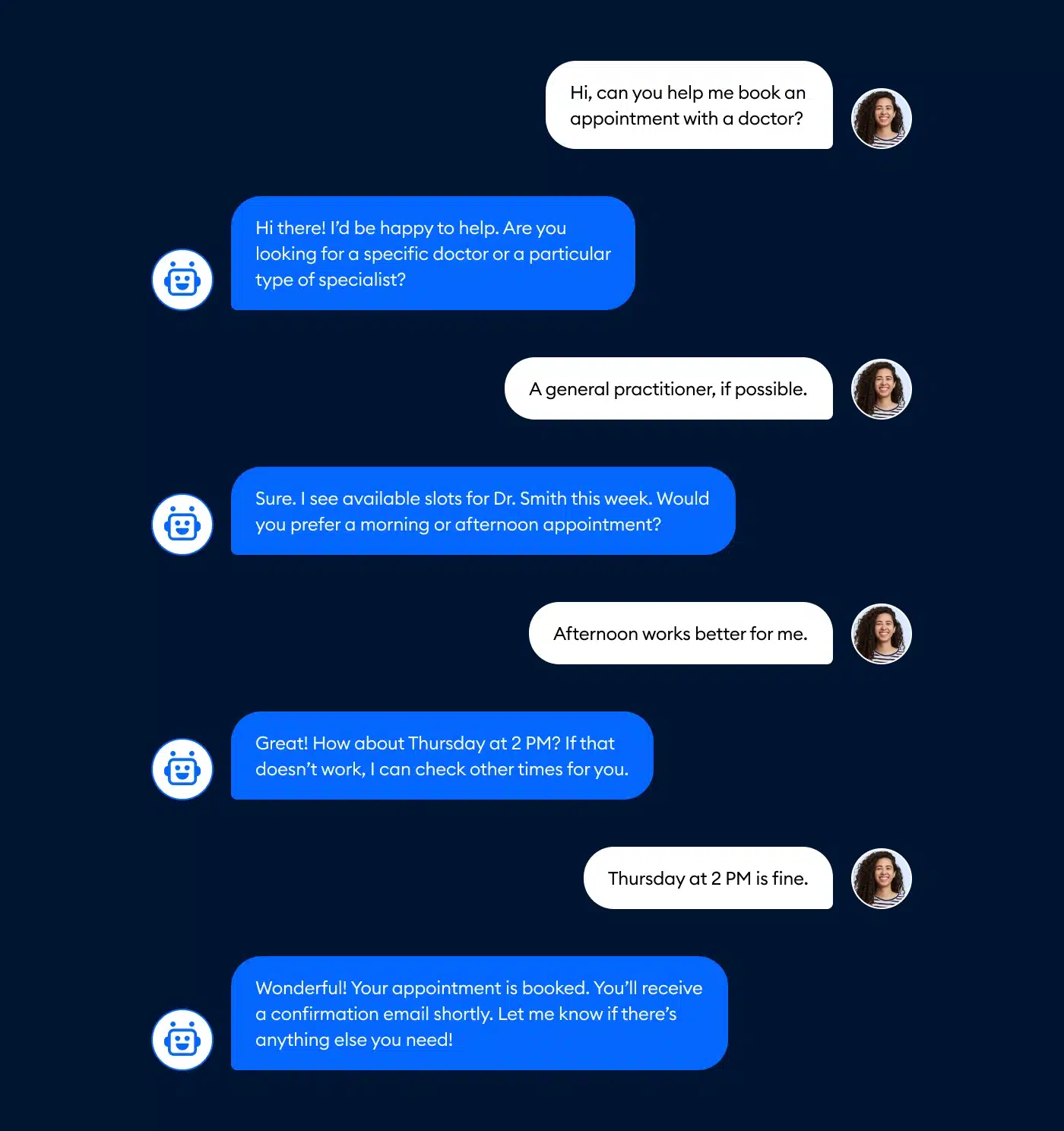
Read more: Explore the best chatbot use cases for customer service.
Bring your chatbot persona to life with Lyro AI
Creating a well-designed AI chatbot personality is key to delivering meaningful and engaging customer interactions. When your bot’s personality aligns with your brand, it builds trust, strengthens your brand identity, and creates an experience that keeps customers coming back.
With Tidio’s Lyro, bringing your chatbot persona to life has never been easier. You can fully customize its tone and messaging style to match your brand and meet your audience’s unique needs. Give Lyro a try and see how it turns your customer interactions into lasting relationships.
Lyro today and create better customer connections!
Frequently Asked Questions
A chatbot persona is like your bot’s overall personality—its traits, quirks, and how it represents your brand. The tone of voice, on the other hand, is how the bot communicates in specific situations. Think of it as the difference between someone’s personality and the way they speak depending on the context.
Not really. A great chatbot persona is one that matches the brand it represents and speaks directly to its audience. Since industries and audiences differ so much, it’s important to create a persona that aligns with your specific needs.
Start by getting to know your audience. Look into what they care about and how they like to interact. Then, make sure your chatbot reflects your brand’s identity in its personality and tone. Tools like Lyro make it easy to tweak and customize everything from tone and language to specific responses, so your bot feels like a natural fit for your business.

